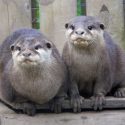
Asian Short Clawed Otter Natural History
Size
They reach lengths of 65cm to 90cm.
Habitat and Distribution
Their habitat ranges from small streams to marshland and mangrove swamps. Their range covers southeastern China up to northern India with scattered ranges across areas of Indonesia.
Age
Their life span in the wild is usually between 10 and 15 years. However, in zoos they have been kept for over 20 years.
Diet
These otters make up most of their diet with crabs and mollusks, as well as any other organisms it can find at the bottom of rivers and ponds. However, being opportunistic they will feed on anything they can find, often eating things such as young birds.
Groups and Breeding
This is a very social animal which generally lives in groups of 4 to 8 individuals however it is not uncommon to find groups of up to around 15 animals. They use vocalisations to warn one another of danger and locate each other in the wild, and are thought to have around 12 unique calls.
Females will give birth to 4 to 5 pups on average after a gestation period of 9 weeks.
Threats
These otters are classed as Vulnerable by the IUCN. Their main threats come from habitat destruction in their natural range and from being hunted to fulfill the continuing demand for their fur. They are still also collected for the pet trade to some degree.
Interesting Facts
This is the smallest of all otter species.
The Short Clawed Otters During Your Day Out in Kent
At Wingham Wildlife Park we have a pair of Asian short clawed otters called Jill and Storm. Their enclosure is one of several which make up our Little Himalaya exhibit behind the Dinosaur Zoo and they share this with a pair of Binturongs. They are the smallest otter species and you can really see the size difference when compared to the smooth coated otters which are situated next to our meerkats. Even though they are smaller, they are still huge bundles of fun and can often be seen playing together in their pool and sun bathing on their rocks.
They are fed fresh water fish as the bulk of their diet.
The more you know…
Want to know more about this animal? Check out our keeper blogs about them here.